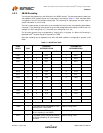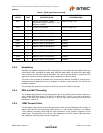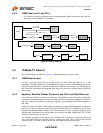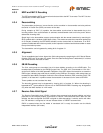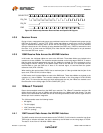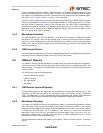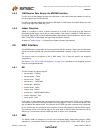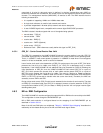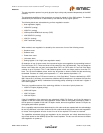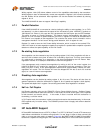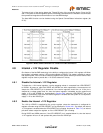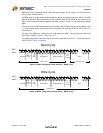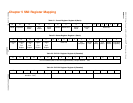
MII/RMII 10/100 Ethernet Transceiver with HP Auto-MDIX and flexPWR
®
Technology in a Small Footprint
Datasheet
Revision 1.0 (04-15-09) 28 SMSC LAN8710/LAN8710i
DATASHEET
Note 4.1 In RMII mode, this pin needs to tied to VSS.
Note 4.2 The RXER signal is optional on the RMII bus. This signal is required by the transceiver,
but it is optional for the MAC. The MAC can choose to ignore or not use this signal.
The RMII REF_CLK is a continuous clock that provides the timing reference for CRS_DV, RXD[1:0],
TXEN, TXD[1:0] and RXER. The LAN8710 uses REF_CLK as the network clock such that no buffering
is required on the transmit data path. However, on the receive data path, the receiver recovers the
clock from the incoming data stream, and the LAN8710 uses elasticity buffering to accommodate for
differences between the recovered clock and the local REF_CLK.
4.7 Auto-negotiation
The purpose of the Auto-negotiation function is to automatically configure the transceiver to the
optimum link parameters based on the capabilities of its link partner. Auto-negotiation is a mechanism
for exchanging configuration information between two link-partners and automatically selecting the
highest performance mode of operation supported by both sides. Auto-negotiation is fully defined in
clause 28 of the IEEE 802.3 specification.
Once auto-negotiation has completed, information about the resolved link can be passed back to the
controller via the Serial Management Interface (SMI). The results of the negotiation process are
reflected in the Speed Indication bits in register 31, as well as the Link Partner Ability Register
(Register 5).
Table 4.2 MII/RMII Signal Mapping
LAN8710 PIN NAME MII MODE RMII MODE
TXD0 TXD0 TXD0
TXD1 TXD1 TXD1
TXEN TXEN TXEN
RXER/
RXD4/PHYAD0
RXER RXER
Note 4.2
COL/CRS_DV/MODE2 COL CRS_DV
RXD0/MODE0 RXD0 RXD0
RXD1/MODE1 RXD1 RXD1
TXD2 TXD2 Note 4.1
TXD3 TXD3 Note 4.1
nINT/TXER/TXD4 TXER/
TXD4
CRS CRS
RXDV RXDV
RXD2/RMIISEL RXD2
RXD3/PHYAD2 RXD3
TXCLK TXCLK
RXCLK/PHYAD1 RXCLK
XTAL1/CLKIN XTAL1/CLKIN REF_CLK



